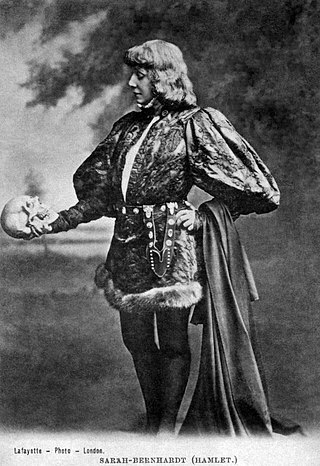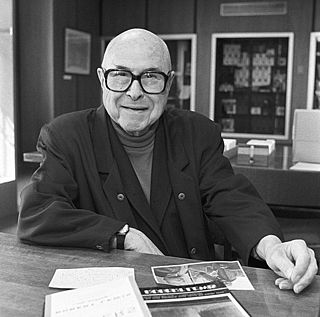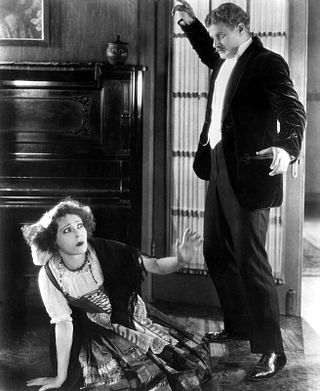Related Research Articles

Acting is an activity in which a story is told by means of its enactment by an actor who adopts a character—in theatre, television, film, radio, or any other medium that makes use of the mimetic mode.

Konstantin Sergeyevich Stanislavski was a seminal Soviet Russian theatre practitioner. He was widely recognized as an outstanding character actor, and the many productions that he directed garnered him a reputation as one of the leading theatre directors of his generation. His principal fame and influence, however, rests on his "system" of actor training, preparation, and rehearsal technique.

Method acting, known as the Method, is a range of rehearsal techniques, as formulated by a number of different theatre practitioners, that seeks to encourage sincere and expressive performances through identifying with, understanding, and experiencing a character's inner motivation and emotions. These techniques are built on Stanislavski's system, developed by the Russian actor and director Konstantin Stanislavski and captured in his books An Actor Prepares, Building a Character, and Creating a Role.

The Power of Darkness is a five-act drama by Leo Tolstoy. Written in 1886, the play's production was forbidden in Russia until 1902, mainly through the influence of Konstantin Pobedonostsev. In spite of the ban, the play was unofficially produced and read numerous times.

The Group Theatre was a theater collective based in New York City and formed in 1931 by Harold Clurman, Cheryl Crawford and Lee Strasberg. It was intended as a base for the kind of theatre they and their colleagues believed in—a forceful, naturalistic and highly disciplined artistry. They were pioneers of what would become an "American acting technique", derived from the teachings of Konstantin Stanislavski, but pushed beyond them as well. The company included actors, directors, playwrights, and producers. The name "Group" came from the idea of the actors as a pure ensemble; a reference to the company as "our group" led them to "accept the inevitable and call their company The Group Theatre."

Stanislavski's system is a systematic approach to training actors that the Russian theatre practitioner Konstantin Stanislavski developed in the first half of the twentieth century. His system cultivates what he calls the "art of experiencing". It mobilises the actor's conscious thought and will in order to activate other, less-controllable psychological processes—such as emotional experience and subconscious behaviour—sympathetically and indirectly. In rehearsal, the actor searches for inner motives to justify action and the definition of what the character seeks to achieve at any given moment.

Lee Strasberg was an American theatre director, actor and acting teacher. He co-founded, with theatre directors Harold Clurman and Cheryl Crawford, the Group Theatre in 1931, which was hailed as "America's first true theatrical collective". In 1951, he became director of the nonprofit Actors Studio in New York City, considered "the nation's most prestigious acting school," and, in 1966, he was involved in the creation of Actors Studio West in Los Angeles.

SanfordMeisner was an American actor and acting teacher who developed an approach to acting instruction that is now known as the Meisner technique. While Meisner was exposed to method acting at the Group Theatre, his approach differed markedly in that he completely abandoned the use of affective memory, a distinct characteristic of method acting. Meisner maintained an emphasis on "the reality of doing", which was the foundation of his approach.

Stella Adler was an American actress and acting teacher.

Richard Boleslawski was a Polish theatre and film director, actor and teacher of acting.

Harold Edgar Clurman was an American theatre director and drama critic. In 2003, he was named one of the most influential figures in U.S. theater by PBS. He was one of the three founders of New York City's Group Theatre (1931–1941). He directed more than 40 plays in his career and, during the 1950s, was nominated for a Tony Award as director for several productions. In addition to his directing career, he was drama critic for The New Republic (1948–1952) and The Nation (1953–1980), helping shape American theater by writing about it. Clurman wrote seven books about the theatre, including his memoir The Fervent Years: The Group Theatre and the Thirties (1961).

The Moscow Art Theatre (or MAT; Russian: Московский Художественный академический театр, Moskovskiy Hudojestvenny Akademicheskiy Teatr was a theatre company in Moscow. It was founded in 1898 by the seminal Russian theatre practitioner Konstantin Stanislavski, together with the playwright and director Vladimir Nemirovich-Danchenko. It was conceived as a venue for naturalistic theatre, in contrast to the melodramas that were Russia's dominant form of theatre at the time. The theatre, the first to regularly put on shows implementing Stanislavski's system, proved hugely influential in the acting world and in the development of modern American theatre and drama.

Robert Lewis was an American actor, director, teacher, author and founder of the influential Actors Studio in New York in 1947.
Twentieth-century theatre describes a period of great change within the theatrical culture of the 20th century, mainly in Europe and North America. There was a widespread challenge to long-established rules surrounding theatrical representation; resulting in the development of many new forms of theatre, including modernism, expressionism, impressionism, political theatre and other forms of Experimental theatre, as well as the continuing development of already established theatrical forms like naturalism and realism.
My Life in Art is the autobiography of the Russian actor and theatre director Konstantin Stanislavski. It was first commissioned while Stanislavski was in the United States on tour with the Moscow Art Theatre, and was first published in Boston, Massachusetts in English in 1924. It was later revised and published in a Russian-language edition in Moscow under the title Моя жизнь в искусстве. It is divided into 4 sections entitled: 1-Artistic Childhood, 2-Artistic Youth, 3-Artistic Adolescence and 4-Artistic Adulthood.

Realism in the theatre was a general movement that began in 19th-century theatre, around the 1870s, and remained present through much of the 20th century. It developed a set of dramatic and theatrical conventions with the aim of bringing a greater fidelity of real life to texts and performances. These conventions occur in the text, design, performance style, and narrative structure. They include recreating on stage a facsimile of real life except missing a fourth wall. Characters speak in naturalistic, authentic dialogue without verse or poetic stylings, and acting is meant to emulate human behaviour in real life. Narratives typically are psychologically driven, and include day-to-day, ordinary scenarios. Narrative action moves forward in time, and supernatural presences do not occur. Sound and music are diegetic only. Part of a broader artistic movement, it includes Naturalism and Socialist realism.

The Moscow Art Theatre production of Hamlet was a 1911–12 production of Hamlet, produced by Konstantin Stanislavski and Edward Gordon Craig. It is particularly important in the history of performances of Hamlet and of 20th-century theatre in general. Despite hostile reviews from the Russian press, the production attracted enthusiastic and unprecedented worldwide attention for the theatre, with reviews in Britain's The Times and in the French press that praised its unqualified success. The production placed the Moscow Art Theatre "on the cultural map for Western Europe", and it came to be regarded as a seminal event that influenced the subsequent history of production style in the theatre and revolutionised the staging of Shakespeare's plays in the 20th century. It became "one of the most famous and passionately discussed productions in the history of the modern stage."
The Stella Adler Studio of Acting is a prestigious acting school that was founded by actress and teacher Stella Adler. The Stella Adler Studio of Acting has two locations: its original New York City conservatory, founded in 1949, and the Art of Acting Studio in Los Angeles. The Stella Adler Studio of Acting in New York is not affiliated with the Stella Adler Academy & Theatre, which Adler established in Los Angeles in 1985. The Stella Adler Studio and the Juilliard School currently boast the lowest program acceptance rates in the professional acting world. The studio only accepts 28 students a semester into its professional conservatory program.
The Michael Howard Studios is an acting studio for the performing arts located in at 152 West 25th Street in Chelsea, Manhattan, New York City; the studio was founded in 1953 by actor/director Michael Howard.
Dramatic Workshop was the name of a drama and acting school associated with the New School for Social Research in New York City. The German expatriate stage director Erwin Piscator began a long association with the school in 1940. Among the faculty were Lee Strasberg and Stella Adler, among the students Robert De Niro, Marlon Brando, Tony Curtis, Beatrice Arthur, Walter Matthau, Tennessee Williams and Elaine Stritch. The Dramatic Workshop considerably contributed to the resurgence of the Off-Broadway theatre.
References
- ↑ "Laboratory Theatre Exhibits Work" (PDF). The New York Times. May 4, 1928.
- 1 2 "The Theatre: Revivals". Time. January 20, 1930. Archived from the original on February 4, 2013.
- 1 2 "To Succeed Boleslavsky" (PDF). The New York Times. September 30, 1929.
- 1 2 3 4 Hartnoll, Phyllis; Found, Peter, eds. (1992). The Concise Oxford Companion to the Theatre (2nd ed.). Oxford University Press.
- 1 2 3 Stanton, Sarah; Banham, Martin, eds. (1996). Cambridge Paperback Guide To Theatre. Cambridge University Press. p. 11.
- 1 2 3 4 Mahoney, Tom (1960). The Story of George Romney: Builder, Salesman, Crusader. Harper & Brothers. pp. 94–95.
- 1 2 3 4 "New York Giants vs. Chicago Bears". The Spolin Center. Archived from the original on March 11, 2012. Retrieved March 3, 2012.
- ↑ "Ransom Center acquires Stella Adler archive". University of Texas. April 26, 2004. Archived from the original on October 21, 2012. Retrieved March 3, 2012.
- ↑ "OBITUARIES: Richard Aldrich". Variety . 322 (13): 264–265. April 23, 1986.